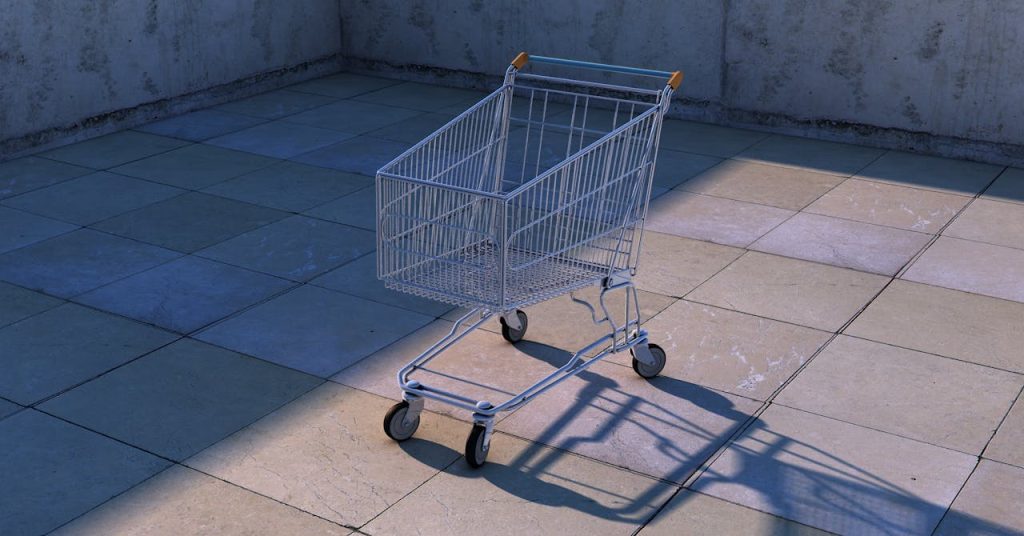

Shopping cart abandonment is one of the most frustrating conversion killers in e-commerce. You’ve done the hard work including (but definitely not limited to) attracting the right traffic, getting them to browse, even convincing them to add products to their cart. Then, they vanish.
Our guide will help you understand why this happens and what you can do about it with a three-level action plan.
Key takeaways
- Measure your cart abandonment rate and benchmark against your industry
- Segment data by device, traffic source, and cart value to spot problem areas
- Identify three abandoner types: price-conscious, anxious, and impatient
- Fix quick wins first: simplify checkout, add trust signals, show costs early
- Roll out mid-term improvements like faster page loads and flexible payment options
- Use long-term tactics like cart recovery emails and retargeting ads to win back lost sales
- Test changes systematically with A/B testing focused on high-impact elements
- Track meaningful metrics like checkout completion rate and time to purchase
- Use Deadline Funnel’s Abandoned Cart Email Solution to give real urgency and draw in more sales.
The diagnosis: Understanding your abandonment rate
Before you can fix cart abandonment, you need to know where you’re losing people and how often. Your cate abandonment rate is a signal that something’s not working as expected in your checkout flow, and customers are walking away.
Let’s start by getting clear on what you’re actually measuring.
What counts as cart abandonment?
Cart abandonment is when a shopper adds items to their cart but doesn’t complete the purchase. That’s the basic definition, but how you track it depends on your setup.
Most analytics tools define abandonment as a session where:
- A product is added to the cart
- The user doesn’t complete the checkout
- The session ends or the user leaves the site
If you’re using Google Analytics 4 (GA4), you’ll need to configure events like add_to_cart, begin_checkout, and purchase to track abandonment properly. Without these, you’re just guessing.
Best practice: Set up a funnel visualization that starts with add_to_cart and ends with purchase. This helps you see exactly where people drop off, whether it’s at shipping, payment, or review.
What’s a “normal” abandonment rate?
It depends on your industry, product type, and checkout experience. But here’s a rough benchmark:
| Industry | Average Abandonment Rate |
|---|---|
| Retail | 70–75% |
| Travel | 80–85% |
| Fashion & Apparel | 75–80% |
| B2B SaaS (free trial conversion rate) | 60–70% |
If you’re consistently above 80%, that’s a red flag. However, even a 60% rate can hide problems if your average order value is high or your funnel is complex.
Example: A B2B SaaS company offering a free trial might see a 65% abandonment rate. But if most users drop off after hitting a credit card form, that’s not normal, it’s a sign that something’s wrong with how they’re presenting payment requirements.
How to spot patterns in your abandonment data
Raw percentages don’t tell the full story. You need to slice the data to find patterns. Start by segmenting by:
- Device type (desktop vs. mobile)
- Traffic source (paid, organic, referral)
- Cart value (low vs. high spenders)
- Time of day or day of week
You might find that mobile users abandon carts at a 20% higher rate than desktop users. That could point to a checkout flow that’s not optimized for small screens.
How to calculate cart abandonment rate
Here’s the basic formula:
Cart Abandonment Rate = (1 – [Completed Purchases ÷ Carts Created]) × 100
Let’s say 500 people added items to their cart, but only 125 checked out. That means 375 people abandoned their cart. The math looks like this:
(1 – 125 ÷ 500) × 100 = 75% abandonment rate
You can usually find this number in your e-commerce platform’s analytics dashboard, but it helps to understand how it’s calculated, especially if you’re comparing across tools or setting up custom tracking.
After knowing what your abandonment rate is, the next step is figuring out why.
Tip: Use our free cart abandonment diagnoser to get your abandonment rate, and quick insights into what’s causing users to leave their carts unbought.

The “why”: Decoding the 3 main types of cart abandoners
Not all cart abandoners behave the same way or leave for the same reasons. To cut down on abandoned carts, you need to understand who’s leaving and why.
Each group has different motivations, behaviors, and triggers. That means they also need different strategies to bring them back.

The price-conscious shopper: “Is this really worth it?”
This person was ready to buy, until they saw the final total. Something tipped the scale and made them back out.
What usually causes it:
- High or unexpected shipping fees
- Surprise taxes or handling costs
- No visible way to save (no promo code, no bundle offer)
- Confusion over true pricing
The anxious shopper: “Can I trust this company?”
This shopper hesitates because something feels off. It’s not that they don’t want the product, they just don’t feel confident enough to pull the trigger.
What shakes their trust:
- No trust signals (no SSL badge, generic design)
- Confusing or missing return policy
- No reviews, testimonials, or social proof
- Being forced to make an account or download an app
The impatient shopper: “This is taking too long!”
These folks aren’t confused or wary, they’re just busy or have a short attention span at the moment. If checkout feels like a chore, they’ll bail and come back maybe never.
What slows them down:
- Long or clunky checkout forms
- Pages that load like it’s 2009
- Having to re-enter info
- No PayPal, Apple Pay, or other fast options
The abandonment matrix
Here’s a quick breakdown of each abandoner type and what you can fix this week vs. what to plan for this quarter.
| Abandoner Type | Common Reason | Quick Fix (Do This Week) ✅ | Strategic Fix (Do This Quarter) 🚀 |
| Price-Conscious | Unexpected Shipping Costs | Add a free shipping threshold banner | Negotiate better rates with carriers |
| Anxious | Forced Account Creation | Enable guest checkout | Add social login (Google, Facebook, etc.) |
| Impatient | Complex Checkout | Remove optional form fields | Redesign to a one-page checkout |
Your 3-level action plan to fix the leaks
Once you’ve diagnosed your abandonment rate and identified the types of cart abandoners, it’s time to plug the holes.
This section gives you a practical, three-level framework to reduce cart abandonment: quick wins, mid-term optimizations, and long-term strategic shifts. Each level builds on the last, so you can act fast without losing sight of the bigger picture.
Level 1: Quick wins you can implement this week
Start with low-effort, high-impact changes. These are fixes you can roll out in hours or days, not weeks.
1. Simplify the checkout process.
If your checkout has more than three steps, you’re asking for drop-offs. Cut unnecessary fields, remove forced account creation, and auto-fill wherever possible. For example, let users check out as guests and offer account creation after purchase.
2. Add trust signals.
Shoppers bail when they’re unsure. Add clear return policies, security badges, and contact info above the fold. Don’t bury this in the footer.
4. Be radically transparent with costs
Hidden shipping fees are abandonment fuel. Show estimated shipping as early as possible, ideally right on the product or cart page. A shipping calculator works great here.
5. Add a progress bar
If checkout has multiple steps, show a progress bar. It reassures shoppers that they’re almost done and reduces the feeling of friction.
6. Show payment and security logos
Include familiar icons (Visa, PayPal, SSL, etc.) at checkout. These might seem like small details, but they give people the extra nudge they need to trust your site and complete the order.
7. Trim your forms
Every unnecessary field is a chance to lose someone. Do you really need their phone number? Their company name? If it’s not essential, cut it.
The quick fixes can sway abandoners, but there could still be issues to address on a less immediate basis.
Level 2: Mid-term improvements that reduce friction
These changes take more planning but can significantly improve conversion rates.
1. Optimize page speed and mobile UX.
Slow load times kill momentum. Aim for under three seconds on mobile. Tools like Google PageSpeed Insights or WebPageTest can help pinpoint issues.
2. Offer flexible payment options.
Some users leave because you don’t support their preferred method. Add Apple Pay, PayPal, and buy-now-pay-later options like Affirm or Klarna. Test which ones convert best with your audience.
3. Improve cart visibility and save state.
Persistent carts (where items stay saved across sessions) help returning users pick up where they left off. Also, show a mini-cart icon with item count on every page. It keeps the cart top of mind.
4. Use exit-intent popups wisely.
A well-timed offer, like 10% off or free shipping, can save a cart. But don’t overdo it. One exit-intent popup per session is enough.
5. Offer live chat
Sometimes people just have a question or small concern that stalls the sale. Adding live chat (or even a chatbot) can reduce hesitation in the moment and prevent abandonment entirely.
Level 3: Long-term strategies to build trust and loyalty
Once the basics are solid, focus on building systems that reduce abandonment over time.
If someone abandons their cart, the story’s not over. Most shoppers need more than one nudge to come back. and you’ve got multiple chances to do it right. This level is all about post-abandonment strategies that turn lost revenue into recovered sales.
1. Send an abandoned cart email sequence
Don’t stop at one reminder. A well-timed, well-written sequence can recover a surprising number of sales. Start with a gentle nudge, then follow up with urgency, and finally, offer an incentive if they still haven’t checked out.
Take it a step further with Deadline Funnel’s Abandoned Cart Email Solution. It syncs timers across emails and landing pages, creating real urgency that helps turn “maybe later” into “bought it!”
[Try 14 days free]
2. Use retargeting ads
After they leave, stay visible. Show them the exact product they left behind via Facebook, Instagram, or Google Display Network. These are low-effort, high-conversion touchpoints if you get the timing right.
3. Keep urgency consistent across channels
If your site uses a countdown, your emails should too. With Deadline Funnel, you can sync the deadline across all channels—so whether someone’s on your site or in their inbox, the offer always feels real (because it is).
The 3-email recovery sequence
Here’s a plug-and-play format you can test this week:
| Timing | Goal | Sample Subject Line | |
| #1 | 1 Hour Later | Gentle Reminder + Offer Help | “Did you forget something?” |
| #2 | 24 Hours Later | Create Urgency or Social Proof | “Your cart is expiring… others love this item!” |
| #3 | 3 Days Later | Sweeten the Deal | “Still thinking it over? Here’s 10% off.” |
With this three step plan, you’re well on your way to recovering lost buyers. But that’s not where the work ends, you’ll still need to test and optimize your strategies over time.
The advanced toolkit: A/B testing your way to fewer abandoned carts
Once you’ve identified where and why shoppers are dropping off, it’s time to experiment. A/B testing gives you a structured way to test hypotheses, validate ideas, and improve your checkout experience without guessing.
Done in the right way, it helps you reduce friction, build trust, and recover revenue that would otherwise be lost to abandoned carts.
Start with high-impact test areas
Not every part of the checkout flow is worth testing right away. Focus on elements that directly influence buyer hesitation or friction.
Three areas that typically move the needle:
- Shipping costs and timing: Test how showing estimated delivery dates earlier in the flow affects completion. Try variations like “Free shipping over $50” vs. “Standard shipping: $5 flat rate.”
- Guest checkout vs. account creation: If you require account creation, test a guest checkout option. Even just rewording the prompt (“Continue as guest” vs. “Skip login”) can make a difference.
- Payment options: Offer multiple payment methods, then test which ones increase conversions. Adding digital wallets like Apple Pay or PayPal can reduce drop-off, especially on mobile.
Start with one variable per test. Multivariate testing sounds appealing, but it’s harder to isolate what’s working unless you have high traffic.
Measure what matters, not just what’s easy
It’s tempting to chase small wins like button colors or font sizes, but those rarely impact abandonment rates in a meaningful way. Instead, focus on metrics tied to user intent and friction.
Key metrics to track:
- Cart-to-checkout rate: Are more users starting the checkout after your change?
- Checkout completion rate: Are more users finishing the process?
- Time to complete checkout: Is the process faster or smoother?
- Drop-off by step: Are fewer users exiting at a specific stage?
Use a testing platform that integrates with your analytics stack so you can segment results by device, traffic source, and user type. A test that works for returning users on desktop might not help first-time mobile shoppers.
Build a testing cadence and document learnings
Random, one-off tests won’t get you far. Build a testing calendar and treat it like a product development cycle.
Here’s a simple process to follow:
- Prioritize based on impact and effort. Use a framework like ICE (Impact, Confidence, Ease).
- Hypothesize based on user behavior. “We believe reducing form fields will increase completion rate.”
- Test with a 50/50 traffic split and a clear success metric.
- Analyze results with statistical significance. Don’t call a winner too early.
- Document what worked, what didn’t, and why. Reuse learnings across other funnels.
A/B testing isn’t a silver bullet, but it gives you the data to make smarter decisions. When paired with the insights from abandonment diagnostics and user behavior, it becomes a powerful tool to recover lost revenue and improve the buying experience.
Conclusion: Don’t let abandonment be the end of the story
Cart abandonment isn’t a one-time event, it’s a pattern. And like any pattern, it can be understood, addressed, and improved.
If you’re just getting started, focus on the quick wins. Enable guest checkout. Add a free shipping banner. Show your return policy above the fold. These changes take minutes, not weeks, and they work.
Once your basics are solid, build out the rest. You don’t need to fix everything at once, you just need to start moving.
The good news? Every small improvement compounds. And when you build a store that’s easy to trust, quick to navigate, and clear about its value, fewer customers disappear.
Need help creating real urgency that drives action (without the sleazy countdown tricks)? Try Deadline Funnel free and see how personalized timers can plug leaks, boost conversions, and give your best offers a real deadline.




